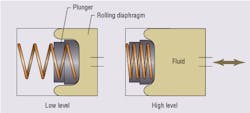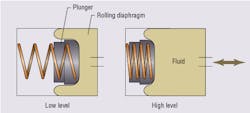Rolling diaphragm reservoir
The rolling diaphragm reservoir is a design that has proven to be reliable and cost-effective. The reservoir consists of a cup-shaped, fiber-reinforced rubber diaphragm, which is held between a plunger and housing. As the plunger cycles in and out, the diaphragm rolls while maintaining contact with the plunger and inner wall of the housing. This is illustrated at right (the convolution size is exaggerated for clarity).
The spring, which is used to apply the required pressure to the fluid, has a low spring rate to minimize the pressure variation between minimum and maximum fluid quantity. The spring provides positive inlet pressure to the pump and maintains a slight differential pressure across the diaphragm to maintain the shape of the convolution. A small atmospheric vent within the spring chamber allows for movement of the diaphragm. This membrane design provides a continuous seal with only one static seal, an important design feature.
The advantages of a rolling diaphragm reservoir include high reliability, low cost and weight, and positive inlet pressure to the pump. It is an effective way to accommodate variable fluid volume while sealing the fluid from the atmosphere.
For more information on the rolling diaphragm reservoir, email [email protected].


